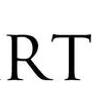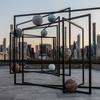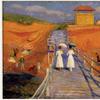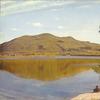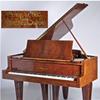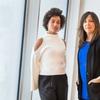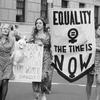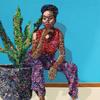Attention Closely Paid: The Artists of Gallery One at Provenance Center
- NEW LONDON, Connecticut
- /
- February 20, 2014
In the ensuing year since The Clayhouse in Old Saybrook, CT closed its doors (a gallery space in which a half dozen Gallery One exhibitions were held each year) this community of thirteen mid-career artists, whose work embraces a range of styles and media, have exhibited in Guilford and New Haven. They are now pleased to announce that their work will be at the Gallery at Provenance Center in New London, a location that marks the farthest east along the shoreline that this gallery-less, yet cohesive group of visionary artists have gathered their work for public display.
In preparing for this show, the artists of Gallery One chose to align their artistic intentions with the overall mission of the Provenance Center Gallery, which is to serve as “a non-traditional space for art exhibits and other artistic events signifying mankind’s unending desire for social and spiritual connectedness.” Because the thirteen each represent different backgrounds and traditions, they decided to focus on a unifying theme, most clearly characterized by the word “attention” -- not casual attention, but rather that quality of deep attention that emerges during extended periods of intense engagement in the creative process.
“Attention Closely Paid” is the phrase the artists are using for what each perceives as a healing space in personal and in cultural terms. “When I’m not in my studio,” Judith Barbour Osborne claims, “I feel less balanced, less able to view things in their natural complexity.” At such times, when the deep concentration of art-making is put aside for periods of time, “I react by wanting to change or control things.” In contrast, an intense engagement in art-making is for Osborne, and doubtless many other deeply concentrating makers, connected “with peace, equanimity, harmony, a richness in life, and an ability to see possibilities.”
Each of the artists of Gallery One pays attention in his or her unique way in order to gain a deeper and richer understanding of the meaning of their work. T. Willie Raney, for example, concentrates at present on “what layers mean and how they can be created” -- layers that signify time, history, the rich texture of lived experience. Ashby Carlisle will be exhibiting the second of three sculptural works from her Seeds of Heaven Series. In this piece, Carlisle uses words from newspapers of the four largest populations on earth (Spanish, Arabic, Chinese and English) to express the view that humans have the capacity to create heaven or hell in their day-to-day experience. “From my perspective,” Carlisle writes, “these populations have the greatest ability to influence values and ultimately the actions of people around the globe which, in turn, would affect the state of life for both plants and animals.” She has placed these words upside down on the seedpods of the ailanthus altissima tree, because the seedpods grow up and out of the tree and turn upside down as they fall to earth. (This ancient tree is commonly known as the Tree of Heaven). As Carlisle sees it: “These are the seeds of heaven’s potential here on earth which we create.”
Gray Jacobik’s abstract paintings are influenced primarily by images of the earth from space and of deep space. In her view, these images, newly lodged in human psyches, have the potential to influence individual and collective conceptions of self and of community. “They have the power to move us from egocentrism and nationalistic worldviews toward a view of ourselves as citizens of the cosmos.” As Jacobik explains it, “when I’m deeply engaged in painting, I experience myself as ‘centerless’ and this is liberating and healing. My intention is that some slight whiff of the freedom and ease, of non-being, is carried forth into the painting itself and can be perceived as a possibility by others.”
Judith Barbour Osborne is a visual artist whose work is guided by words from poems and spiritual texts. She does this because she is interested in both verbal and non-verbal ways of knowing, and in unifying the visual images of words with their signifying power. In explaining her experience of attention closely paid, Osborne feels a sense of “being reduced, if you will, to ‘merely’ the observer,” a state in which “much more is available to me, but carries very little or no personal urgency. It is simultaneously peaceful and energy-filled.” In an Osborne work, segments of the texts become simultaneous, with multiple meanings and associations equally present. It is her aspiration that a viewer who brings him- or herself to her work, will experience “no space for an ordinary limited sense of self.”
A Gallery One exhibit offers viewers a broad variety of intellectually and visually stimulating experiences. Its artists are sculptors, painters, printmakers, calligraphers and photographers whose work encompasses representational and expressive styles as well as the abstract and non-objective. At a Gallery One exhibition, you are as likely to find an artist’s careful rendering of a subject caught in a particular light, as you are to encounter a wholly expressive gestural depiction of the figure, or a work whose objectives are solely material and procedural.
More than 50 works will be on display beginning with the opening reception on Sunday, February 23 from 1:00-4:00 pm. The gallery will be open Wednesday through Saturday thereafter, from 1:00-5:30 pm. Several of the artists will speak briefly about their work during a closing reception on Sunday, April 6.
In addition to the artists mentioned above (Ashby Carlisle, Gray Jacobik, Judith Barbour Osborne, and T. Willie Raney), other artist-members of Gallery One are Elizabeth Gillies Boyd, David Brown, Catherine Christiano, Bette Ellsworth, Mary Fussell, Suzanne Wind Gaskell, Diana Rogers, Hillary Steiner Seltzer and Jill Vaughn.


